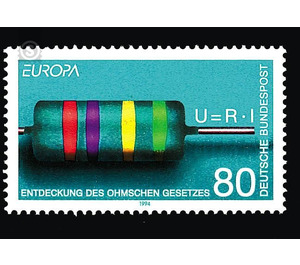Europe - Germany / Federal Republic of Germany 1994 - 80 Pfennig
Theme: Post & Philately
| Country | Germany / Federal Republic of Germany |
| Issue Date | 1994 |
| Face Value | 80.00 |
| Color | green blue |
| Perforation | K 14 |
| Printing Type | Multicolor offset printing |
| Stamp Type | Postage stamp |
| Item Type | Stamp |
| Chronological Issue Number | 1605 |
| Chronological Chapter | GER-BRD |
| SID | 616631 |
| In 28 Wishlists | |
At the time when Georg Simon Ohm (Erlangen 1781 to 1854 Munich) studied physics in his birthplace, the understanding of electricity was still in its infancy. If the regularities between stationary charges were already well known, then the phenomena of the moving charges were almost misunderstood. At the beginning of the 19th century, the first battery ("galvanic cell") was used to generate moving charges, i. H. Soon afterwards, Oersted discovered the possibility of measuring these currents by acting on magnets. Ohm took advantage of these new insights when he conducted experiments in 1826-27 during his time as a secondary school teacher in Cologne and later in Berlin. His interest was in the question of how the current of such a battery of metals is conducted. Ohm found a proportionality between the flowing electric current and the voltage of the battery. He then set up the law named after him: voltage (U) = constant (R) x amperage (I). For the interpretation of the proportionality constants, he introduced the concept of electrical resistance, which the wire opposes to the flow of current. He also discovered that this resistance is material dependent and increases with the length of the wire. With this, Ohm laid the foundation for a theory of electric circuits. His special merit is the exact mathematical treatment of the phenomena studied and a scientifically accurate definition of the terms current and voltage. In appreciation of his fundamental work, the unity of electrical resistance bears his name (symbolically O). (Text: Physics Institute Bonn, Ariane Frey)


